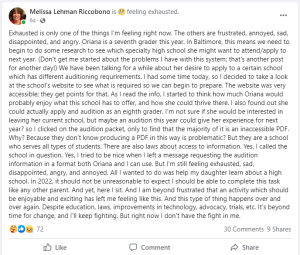
PDF Accessibility is critical
Most organizations share at least some information using PDFs. Most of us open and use these PDFs without thinking about it. But for people who use assistive technology to read digital documents, which can include as many as 20-25% of the population, inaccessible PDFs can make everyday tasks difficult or even impossible. This story happened to my real-life friend. It explains why it’s critical for organizations to include accessibility as part of their workflows.
A parent’s frustration
I was scrolling through Facebook the other day and saw this post from my friend, Melissa Riccobono. Melissa loves to read, sing and tell stories. Her husband runs a multi-million dollar organization. Additionally, she has worked as a school counselor and run multiple state and national educational programs and member organizations. Melissa has a great house and is raising three children. She is also blind, as is her husband. He is the President of the National Federation of the Blind (NFB), the largest blindness organization in the world.
Her post really hit me hard, that such an educated and capable person was completely stopped in her tracks by an inaccessible PDF.

Exhausted is only one of the things I’m feeling right now. The others are frustrated, annoyed, sad, disappointed, and angry. Oriana is a seventh grader this year. In Baltimore, this means we need to begin to do some research to see which specialty high school she might want to attend/apply to next year. (Don’t get me started about the problems I have with this system; that’s another post for another day!) We have been talking for a while about her desire to apply to a certain school which has different auditioning requirements. I had some time today, so I decided to take a look at the school’s website to see what is required so we can begin to prepare. The website was very accessible; they get points for that. As I read the info, I started to think how much Oriana would probably enjoy what this school has to offer, and how she could thrive there. I also found out she could actually apply and audition as an eighth grader. I’m not sure if she would be interested in leaving her current school, but maybe an audition this year could give her experience for next year? so I clicked on the audition packet, only to find that the majority of it is an inaccessible PDF. Why? Because they don’t know producing a PDF in this way is problematic? But they are a school who serves all types of students. There are also laws about access to information. Yes, I called the school in question. Yes, I tried to be nice when I left a message requesting the audition information in a format both Oriana and I can use. But I’m still feeling exhausted, sad, disappointed, angry, and annoyed. All I wanted to do was help my daughter learn about a high school. In 2022, it should not be unreasonable to expect I should be able to complete this task like any other parent. And yet, here I sit. And I am beyond frustrated that an activity which should be enjoyable and exciting has left me feeling like this. And this type of thing happens over and over again. Despite education, laws, improvements in technology, advocacy, trials, etc. It’s beyond time for change, and I’ll keep fighting. But right now I don’t have the fight in me.
Access to information informs decisions
Like any parent, Melissa needed to find information to make the best decisions. That inaccessible PDF blocked her from access to the information she needed to help her choose the right educational program, one that will impact her daughter for a lifetime.
Melissa is persistent and she has resources to help her get access to this document. But it will take time, and it will take effort. And it’s completely unacceptable that she can’t perform a simple parenting task like everyone else.
Ensure PDF accessibility
The school that posted the inaccessible document likely didn’t intend to exclude Melissa or anyone else from accessing their information. Like many organizations, they might have been unaware that the document was inaccessible. Or they may have lacked the time or resources to make it accessible. Accessible PDFs aren’t just added perks organizations who want to “go the extra mile” offer their website users.7ssistive technology users from accessing the information on your website. Additionally, accessible documents are a legal requirement under the ADA. Without them, people with disabilities- as many as 25% of the population- can’t complete everyday tasks. It’s imperative that organizations educate themselves about PDF accessibility and other ADA requirements, and choose tools to meet those requirements efficiently.
Want to learn how you can make your organization’s PDFs accessible? Download our Equidox Guide to PDF Accessibility.
Tammy Albee
Tammy Albee | Director of Marketing | Equidox Tammy joined Equidox after four years of experience working at the National Federation of the Blind. She firmly maintains that accessibility is about reaching everyone, regardless of ability, and boosting your market share in the process. "Nobody should be barred from accessing information. It's what drives our modern society."
Let’s talk!
Speak with an expert to learn how Equidox solutions make PDF accessibility easy.